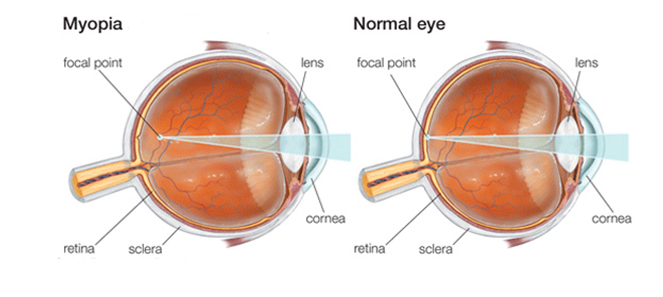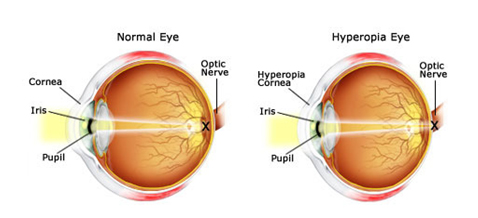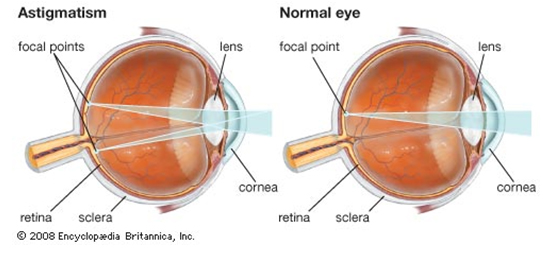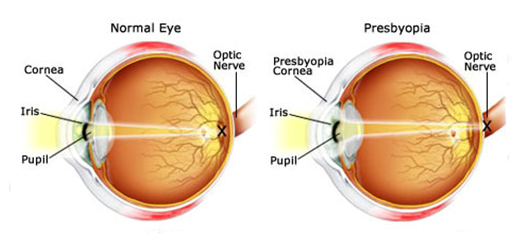
Myopia Treatment
Eye glasses are the Primary choice of correction for persons with nearsightedness. Generally, a single vision lens is prescribed to provide clear vision at all distances. A large selection of lens types and frame designs are now available for patients of all ages. Eye glasses are no longer just a medical device that provides needed vision correction, but can also be a fashion statement. They are available in a wide variety of sizes, shapes, colors and materials that not only correct for vision problems but also may enhance appearance.
For some individuals, contact lenses can offer better vision than eyeglasses. They may provide clearer vision and a wider field of view. However, since contact lenses are worn directly on the eyes, they require regular cleaning and care to safeguard eye health. Refractive surgery, such as LASIK , is another option for correcting myopia. Surgery may reduce or eliminate your need to wear glasses or contact lenses.

Causes of Hypermetropia
The eyeball of a farsighted person is shorter than normal. New borne are usually hypermetropic, and some of them “outgrow” it as the eyeball lengthens with normal growth. Sometimes people confuse hyperopia with presbyopia, which also causes near vision problems but for different reasons.
Hypermetropia Treatment
Farsightedness can be corrected with glasses or contact lenses to change the way light rays bend into the eyes. You may need to wear your glasses or contacts all the time when reading, working on a computer or doing other close-up work. Refractive surgery, such as LASIK , is another option for correcting hyperopia. Surgery may reduce or eliminate your need to wear glasses or contact lenses.

Causes Of Astigmatism
Astigmatism occurs due to the irregular shape of the cornea or the lens inside the eye. The cornea and lens are primarily responsible for properly focusing light entering your eyes allowing you to see things clearly.
The curvature of the cornea and lens causes light entering the eye to be bent in order to focus it precisely on the retina at the back of the eye. In astigmatism, the surface of the cornea or lens has a somewhat different curvature in one direction than another. In the case of the cornea, instead of having a round shape like a basketball, the surface of the cornea is more like a football. As a result, the eye is unable to focus light rays to a single point causing vision to be out of focus at any distance.
Sometimes astigmatism may develop following an eye injury or eye surgery. There is also a relatively rare condition called keratoconus where the cornea becomes progressively thinner and cone shaped. This results in a large amount of astigmatism resulting in poor vision that cannot be clearly corrected with spectacles. Keratoconus usually requires semi soft contact lenses for clear vision, and it may eventually progress to a point where a corneal transplant is necessary.
Astigmatism Treatment
Eyeglasses are the primary choice of correction for persons with astigmatism. They will contain a special cylindrical lens prescription to compensate for the astigmatism. This provides for additional lens power in only specific meridians of the lens.
A wide variety of lens types and frame designs are now available for patients of all ages. Eyeglasses are no longer just a medical device that provides needed vision correction. Eyeglass frames are available in a many shapes, sizes, colors and materials that not only allow for correction of vision, but also enhance appearance.
For some individuals, contact lenses can offer better vision than eyeglasses. They may provide clearer vision and a wider field of view. However, since contact lenses are worn directly on the eyes, they require regular cleaning and care to safeguard eye health.

Some signs of presbyopia include the tendency to hold reading materials at arm’s length, blurred vision at normal reading distance and eye fatigue along with headaches when doing close work. A comprehensive optometric examination will include testing for presbyopia.
Presbyopia Treatment
People with presbyopia usually need treatment for both close-up vision and distance vision. Typically, eyeglasses and contacts are the common choices due to their affordability, availability, and convenience. A few surgical procedures are available, and several more are still undergoing trials. There are a number of different treatment options to presbyopia, like spectacles, contact lenses and refractive surgery.

